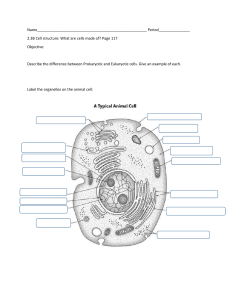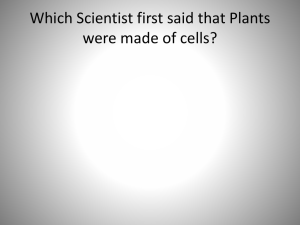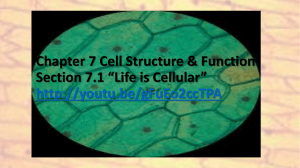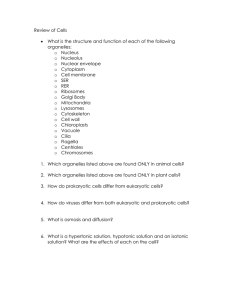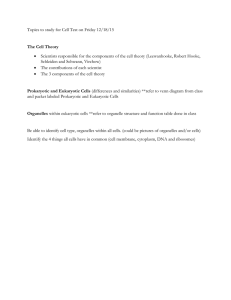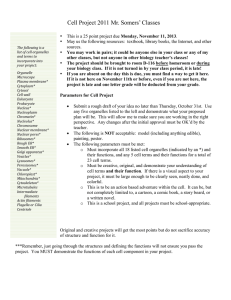Learning log Biology Unit #2
advertisement
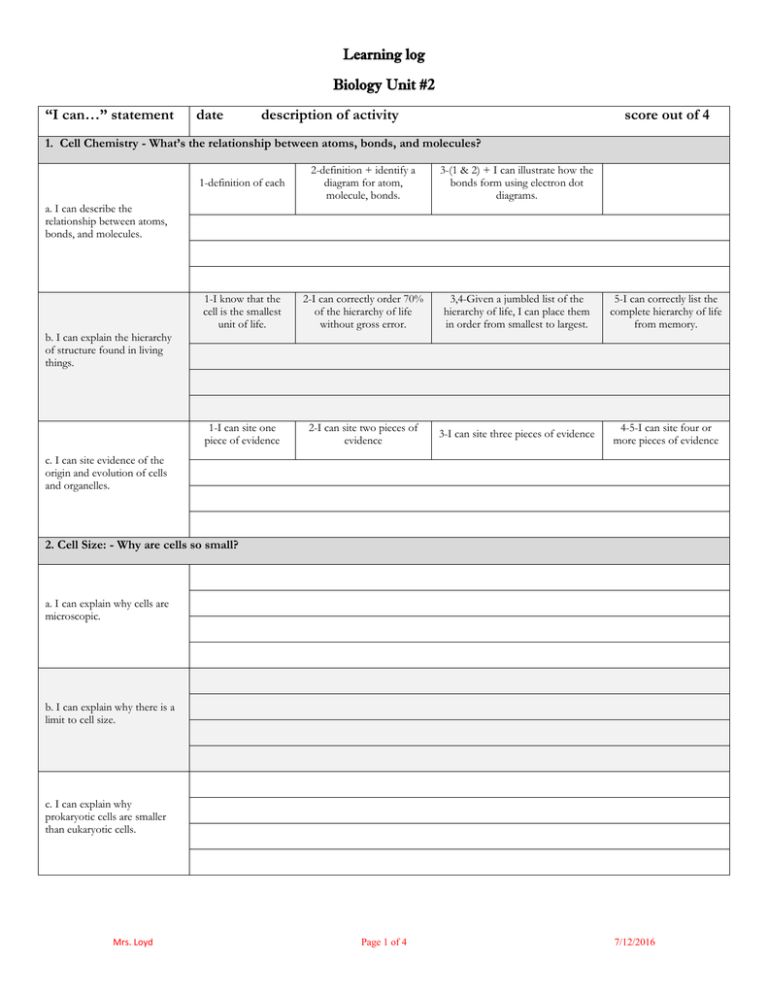
Learning log Biology Unit #2 “I can…” statement date description of activity score out of 4 1. Cell Chemistry - What’s the relationship between atoms, bonds, and molecules? 1-definition of each 2-definition + identify a diagram for atom, molecule, bonds. 3-(1 & 2) + I can illustrate how the bonds form using electron dot diagrams. 1-I know that the cell is the smallest unit of life. 2-I can correctly order 70% of the hierarchy of life without gross error. 3,4-Given a jumbled list of the hierarchy of life, I can place them in order from smallest to largest. 5-I can correctly list the complete hierarchy of life from memory. 1-I can site one piece of evidence 2-I can site two pieces of evidence 3-I can site three pieces of evidence 4-5-I can site four or more pieces of evidence a. I can describe the relationship between atoms, bonds, and molecules. b. I can explain the hierarchy of structure found in living things. c. I can site evidence of the origin and evolution of cells and organelles. 2. Cell Size: - Why are cells so small? a. I can explain why cells are microscopic. b. I can explain why there is a limit to cell size. c. I can explain why prokaryotic cells are smaller than eukaryotic cells. Mrs. Loyd Page 1 of 4 7/12/2016 3. Cell Organelles - How do organelles work to support the cell? a. I can describe the function of the nucleus. ribosomes, rough endoplasmic reticulum, smooth endoplasmic reticulum, Golgi apparatus. b. I can describe the functions of organelles that make or modify macromolecules: c. I can describe the functions of organelles that make energy for cell metabolism: mitochondria and chloroplasts. d. I can describe the functions of organelles that store products in a cell: vacuoles and lysosomes. e. I can describe the functions of the organelles that give the cell shape and structure: cell wall, cytoskeleton. f. I can describe how all the organelles work together to make proteins. Mrs. Loyd Page 2 of 4 7/12/2016 4. Cell Types - How are all cells the same, yet different? a. I can list differences between prokaryotic and eukaryotic cells. b. I can list similarities and differences between animal and plant cells. c. I can identify the organelles in prokaryotic and eukaryotic cells using diagrams. d. I can list which organelles are in all cells. e. I can explain how cells in a multicellular organism can be different even though they all contain the same DNA. 5. Membrane Structure - How are macromolecules arranged to form a membrane? a. I can identify the parts of the plasma membrane from diagrams. b. I can list the function of each part of the plasma membrane. c. I can show how all of the parts of the plasma membrane work together to make it selectively permeable. Mrs. Loyd Page 3 of 4 7/12/2016 d. I can explain how the plasma membrane and its components enable the cell to maintain homeostasis 6. Passive Transport - How do cells transport substances across a membrane without using energy? a. I can explain what passive transport is and why cells do it. b. I can describe osmosis, dialysis, and facilitated diffusion. c. I can predict what will happen to plant and animal cells when placed in the following solutions: hypotonic, hypertonic, and isotonic. 7. Active Transport - How do cells transport substances across a membrane using energy? a. I can explain what active transport is and why cells do it. b. I can describe the sodium/potassium pump, endocytosis and exocytosis. 8. Summary a. I can describe how passive and active transport work together to maintain homeostasis. Mrs. Loyd Page 4 of 4 7/12/2016
